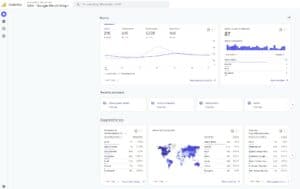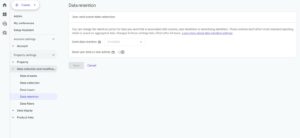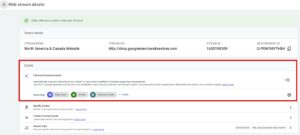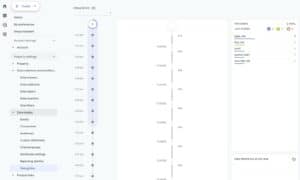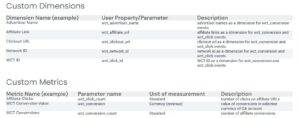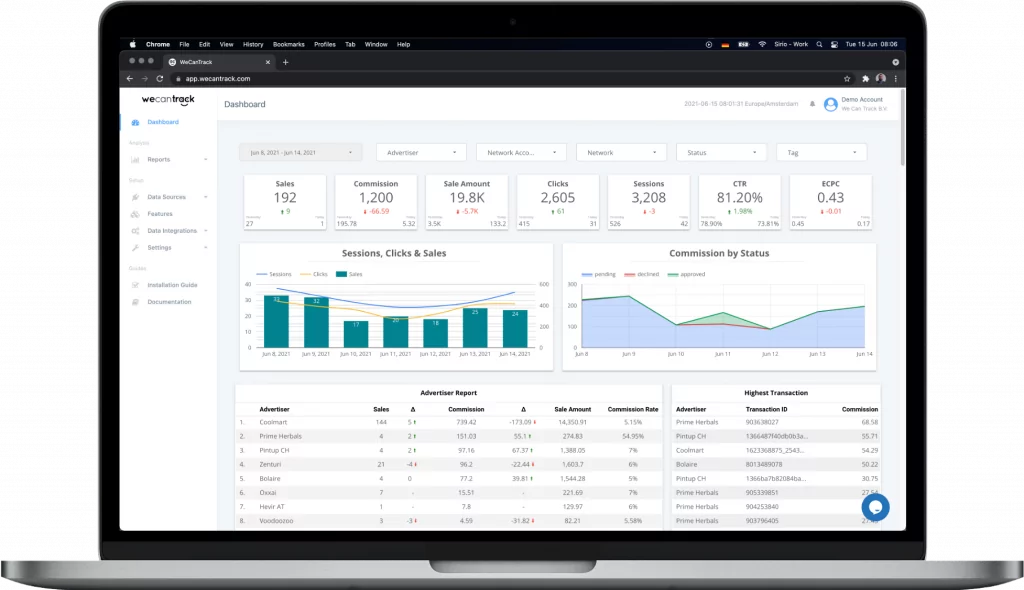In July 2023, the digital marketing world said goodbye to Universal Analytics, which stopped processing new hits. This shift made the transition to Google Analytics 4 (GA4) not just an option, but a necessity for marketers.
In this guide, we’ll explore the transition from Universal Analytics to GA4, highlighting both the opportunities and challenges it presents. We’ll delve into what’s changed, what’s stayed the same, and what these developments mean specifically for affiliate marketers.
Join us as we unpack the essentials of GA4 and help you navigate this new terrain effectively.
Table of Contents
Let’s dive in!
Major Changes In GA4
User Interface Overhaul
In GA4, you’ll first notice its sleek, modern interface. This isn’t just a cosmetic upgrade; it’s a complete redesign for enhanced user experience.
The dashboard is more than just aesthetically pleasing—it’s intelligently organized, making the vast trove of data more accessible and actionable.
Navigational Shifts
Navigating through GA4 is a departure from the familiar paths of Universal Analytics. The interface is engineered for efficiency, minimizing the number of clicks to access crucial data. This streamlined approach helps you focus on what matters most, reducing the time spent on data extraction and increasing time for analysis.
Revolutionized Data Model
Event-Based Tracking
GA4 shifts from the session-based model of UA to an event-based model. This monumental change means every user interaction is captured as an individual event. This approach offers an incredibly detailed view of user behavior, vividly depicting how users interact with your site or app.
Enhanced User Insights
With its event-based model, GA4 enables a deeper understanding of user actions. This granularity allows for more personalized and targeted marketing strategies. You’re not just seeing page views; you’re getting insights into every click, scroll, and interaction, offering a richer, more nuanced understanding of user behavior.
Enhanced Privacy And Data Collection
Adhering To Global Standards
GA4 is built with privacy at its core, responding proactively to global data protection regulations like GDPR and CCPA. This commitment to privacy ensures that your analytics practices are compliant, reducing the risk of penalties and enhancing user trust.
From my perspective, GA4’s commitment to privacy is not just a response to regulations like GDPR and CCPA; it’s a forward-thinking move that aligns with the evolving needs of affiliate marketers who prioritize user trust and compliant practices.
User Privacy Controls
GA4 offers enhanced control over data collection, giving you and your users more power over what’s tracked. These tools are crucial in today’s privacy-conscious environment, allowing for responsible and respectful data usage.
Integration With Google’s Machine Learning
Predictive Analytics
GA4’s integration with Google’s machine learning algorithms opens up a world of predictive analytics. This feature can forecast user behaviors, helping you anticipate needs and effectively tailor your strategies. It’s like having a glimpse into the future powered by data.
Practical Applications
GA4’s machine learning capabilities are not just theoretical. They have practical applications, from predicting purchase probabilities to identifying potential high-value customers. This level of insight can revolutionize how you approach marketing, product development, and customer engagement.
The Benefits Of Transitioning To GA4
Embarking from Universal Analytics to Google Analytics 4 (GA4) isn’t just a step forward; it’s a leap into a realm of possibilities that redefine how we understand and interact with data.
Improved User Tracking
Cross-Platform and Cross-Device Insights: One of GA4’s crown jewels is its ability to track users across platforms and devices.
Imagine seamlessly tracking a user’s journey from a mobile app to a web browser and understanding their holistic interaction with your brand.
This isn’t just about collecting more data; it’s about stitching together a narrative that transcends platforms and devices, offering a comprehensive view of user behavior.
Enhanced Reporting
Customization at Your Fingertips: GA4 turns the tables on one-size-fits-all reporting.
Here, you’re the master of your data universe, able to tailor reports to your specific needs. It’s like having a bespoke suit; it just fits better.
This level of customization means that you can zero in on the metrics that matter most to your business, making data analysis more relevant and actionable.
Richer Data, Deeper Insights: With GA4, reports aren’t just numbers and graphs; they’re stories waiting to be told.
The depth of data available allows for a level of granular and comprehensive analysis.
You’re not just skimming the surface; you’re diving deep into the data ocean, uncovering previously hidden insights.
Better Data Control
Data Retention and Deletion: GA4 puts you in the driver’s seat regarding data retention and deletion.
In an era where data privacy is paramount, having control over how long you keep data and when to delete it is not just a feature; it’s a necessity.
This control helps ensure compliance with privacy laws and builds trust with your users.
Future-Proofing
A Cookie-Less Future and Privacy Compliance: GA4 is designed with the future in mind.
As the digital landscape moves away from cookies and privacy regulations become more stringent, GA4 stands ready.
This future-proofing is crucial for businesses looking to stay ahead of the curve in a rapidly evolving digital world.
In essence, transitioning to GA4 is not just an upgrade; it’s an evolution.
Limitations And Challenges Of GA4
While GA4 is like a shiny new sports car in the world of analytics, it’s not without its bumps in the road.
Let’s go through the challenges and limitations of this new platform, keeping our conversation real and to the point.
Learning Curve
Adjusting to a New Interface and Features: For many, the transition to GA4 is akin to learning a new language.
The interface, while sleek, is a far cry from the familiar terrain of Universal Analytics.
It’s like being a seasoned driver who suddenly has to adapt to a car with all the latest gadgets and buttons – exciting but undeniably daunting. This learning curve can be steep, requiring time and patience to master.
Understanding the Event-Based Model: The shift from a session-based to an event-based model is not just a change; it’s a paradigm shift.
For those who have spent years mastering Universal Analytics, this can feel like starting from scratch.
It’s like being a chess expert and then being told you’re now playing 3D chess – the basics are the same, but the game has profoundly changed.
Data Migration Challenges
Comparing Apples to Oranges: Migrating data from Universal Analytics to GA4 isn’t straightforward.
It’s not just about moving data from point A to point B; it’s about reconciling different data structures.
Differences in Data Reporting: The way GA4 reports data can feel like a whole new world.
Metrics that you’ve grown accustomed to in UA might have different counterparts in GA4 or in some cases, may not exist at all.
This requires not just a technical adjustment but a mental one as you recalibrate your understanding of what these metrics mean in the context of GA4.
Limited Integration With Some Legacy Tools
Compatibility Issues: GA4 doesn’t always cooperate with some of the legacy tools and plugins that integrate seamlessly with Universal Analytics.
This can feel like trying to use your favorite old-school video game controller on the latest gaming console – there’s a chance it might not work as expected.
This can pose significant challenges for businesses that rely on these tools in terms of workflow and data analysis.
The learning curve, data migration issues, and compatibility concerns are real hurdles that must be acknowledged and navigated.
However, like any journey worth taking, the path to mastering GA4 is filled with opportunities for growth and learning.
Embracing these challenges head-on is part of the process, paving the way for a more nuanced and sophisticated approach to digital analytics in the long run.
Affiliate Marketing And GA4
GA4 brings several specialized features and strategies for affiliate marketers that enhance link tracking and affiliate conversion analysis.
Many wrongly claim that integrating affiliate sale data into Google Analytics is impossible. The misconception arises because conversions come from external sources. Tracing them back to their original sessions stumps many publishers and tracking tools.
Our fully automated approach ensures prompt data transfer into your Google Analytics 4 account upon receiving the transactions from the affiliate networks. You can now track affiliate conversions back to sessions/clicks, traffic sources, landing pages, campaigns, and many other dimensions and metrics.
These dimensions and metrics are particularly beneficial in the Exploration section of Google Analytics. For instance, setting up a custom event named ‘affiliate_click’ and ‘wct_advertiser_name’ allowed me to track specific user interactions with affiliate links from each advertiser on my content and campaigns, providing invaluable insights for optimizing my performance.
Enhanced Link Tracking With GA4
GA4 simplifies tracking outbound links with its Enhanced Measurement events.
Enabling this feature in your data stream settings allows you to automatically track outbound link clicks without needing additional code. Additionally, you can use the wct_click events automatically shared with GA4 in your reports to view only outbound affiliate link click data.
The GA4 DebugView is an invaluable tool in this process, allowing real-time monitoring of events on your site, which is essential for troubleshooting and optimizing your analytics implementations.
Creating Custom Events And Dimensions
To specifically other affiliate events, it’s recommended to create custom dimensions and metrics based on the wecantrack data.
With custom definitions in GA4 (Configure > Custom Definitions), you can establish custom dimensions and metrics to glean further insights into clicks and conversions from the integrated data.
Below, we outline the custom dimensions and metrics available for setup with our standard integration:
Detailed instructions can be found in our Google Analytics integration guide.
Conversion Tracking And Attribution
Affiliate marketers can then access all their affiliate conversion and session/click data in their GA4 account.
It’s important to note that custom events might take some time to appear in the events section.
Once all data is available, you can easily toggle the option to mark your custom events like clicks as a secondary conversion for example.
This enables you to accurately track and report on affiliate link clicks and actual conversions over time and see specific conversion data in your traffic acquisition reports.
Navigating Discrepancies And Utilizing UTM Parameters
GA4’s Data-Driven Attribution (DDA) model may present discrepancies compared to traditional reporting tools, especially for non-Google channels like affiliate marketing.
To navigate this, it’s crucial to optimize last-click attribution and compare insights from multiple reporting tools.
Properly utilizing UTM (Urchin Tracking Module) parameters is also key. GA4 requires manual tagging with UTM codes for non-Google channels.
By consistently using UTM parameters for source, medium, and campaign, you can ensure fair and accurate reporting between Google and non-Google channels.
wecantrack Integration For Google Analytics 4
The wecantrack’s Google Analytics integration helps affiliate marketers by enabling the tracking of affiliate sale conversions directly in Google Analytics.
This integration provides full insights into the monetary performance of various dimensions like landing pages, channels, campaigns, and devices, thereby allowing marketers to optimize their content and strategies based on concrete sales data.
It’s essential for affiliate marketers to have as much data available as possible in order to improve and scale their performance.
Best Practices For Using GA4
Navigating the world of GA4 can be likened to mastering a sophisticated piece of technology.
For affiliate marketers, mastering GA4 is akin to unlocking new realms of data intelligence. Embrace its event-based model to track key affiliate actions like link clicks or sign-ups.
Customize your reports to zero in on affiliate campaign performance, and leverage predictive analytics to forecast trends and identify high-value opportunities.
My experience has taught me that staying adaptable and continuously learning is vital in fully harnessing GA4’s capabilities for affiliate marketing success.
Embrace The Event-Based Model
Mastering Event Tracking: At the heart of GA4 is its event-based model, a significant departure from the session-based approach of Universal Analytics. This change requires a mindset shift.
Think of every user interaction as a valuable piece of data. Whether it’s a button click, a video play, or a form submission, each action tells a part of your user’s story.
Embracing this model means paying close attention to these events and understanding how they contribute to your overall objectives.
Custom Event Creation: One of GA4’s strengths is the ability to create custom events tailored to your specific needs. It’s like being a chef with the freedom to create a unique dish.
Analyze your users’ behaviors and craft events that capture those unique interactions.
This bespoke approach allows for more precise and relevant data collection.
Utilize Enhanced Reporting Features
Custom Reports for Tailored Insights: GA4’s reporting capabilities are vast and customizable. Avoid getting lost in a sea of data by focusing on creating reports that directly align with your business goals.
It’s about being a strategic data miner, where you extract only the most valuable gems of information.
Utilize Advanced Segmentation: GA4 allows for more sophisticated user segmentation. This isn’t just about dividing your audience into basic categories; it’s about diving deep into their behaviors and preferences.
Use these advanced segmentation capabilities to gain insights into specific user groups, enhancing your ability to target and engage effectively.
Leverage Predictive Metrics
Predictive Analytics for Proactive Strategies: One of GA4’s standout features is its predictive analytics, using machine learning to forecast user behaviors.
This is like having a crystal ball, giving you insights into potential future actions of your customers.
Use these predictive metrics to inform your marketing strategies, anticipate trends, and stay ahead of the curve.
Continuous Learning and Adaptation
Stay Up-to-Date with GA4 Updates: The digital analytics landscape is constantly evolving, and so is GA4.
Staying on top of new features and updates is crucial. It’s like keeping your toolkit updated; the latest tools often make the job easier and more efficient.
Experiment and Adapt: The best way to learn GA4 is through hands-on experience. Don’t be afraid to experiment with different features and settings.
Treat it like a laboratory where you can test, learn, and iterate. This exploratory approach is key to mastering GA4.
Looking To The Future
As we gaze into the digital horizon, the transition from Universal Analytics to GA4 isn’t just a change; it’s a harbinger of the future of web analytics.
In conclusion, my view as a seasoned digital marketer is that GA4 isn’t just a new analytics platform; it’s a pivotal tool reshaping the future of affiliate marketing.
It offers a glimpse into a more data-driven, user-centric world where marketers can anticipate and meet the evolving needs of their audience.
The Ongoing Evolution Of Digital Analytics
Adapting to a Changing Landscape: The digital world is in a constant state of flux, and GA4 is built to adapt to these changes.
Think of it as a living entity, not just a tool. It’s designed to grow, evolve, and adapt, just like the digital ecosystem it operates in.
This adaptability ensures that your analytics practices remain relevant and effective, no matter how the digital tides turn.
Anticipating Future Trends: GA4’s machine learning and predictive capabilities aren’t just about understanding the present; they’re about foreseeing the future.
As technology advances and user behaviors shift, GA4 stands ready to not just respond to these changes but to anticipate them.
It’s like having a forward-looking radar, constantly scanning the horizon for the next big thing in digital analytics.
Expected Updates And Features In GA4
Continuous Improvement and Innovation: The journey with GA4 is one of continuous improvement. Google is known for its commitment to innovation, and GA4 will undoubtedly see a stream of updates and new features.
Staying attuned to these updates is like keeping your finger on the pulse of the analytics world, ensuring you’re always equipped with the latest tools and insights.
And Finally
As we wrap up our tours of Universal Analytics and GA4, it’s clear that this transition is more than just a change in analytics platforms.
Even though it has quite a few downsides, this was a necessary change.
To continue learning, check out our guide on how to use Google Ads for affiliate marketing.
Julian Juenemann

Julian started and grew venture-backed startups with his unique ‘data first’ approach to Online Marketing. He then founded MeasureSchool.com to help marketers like him, with the data-driven way of digital marketing.

